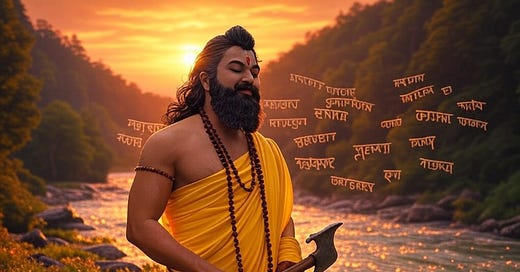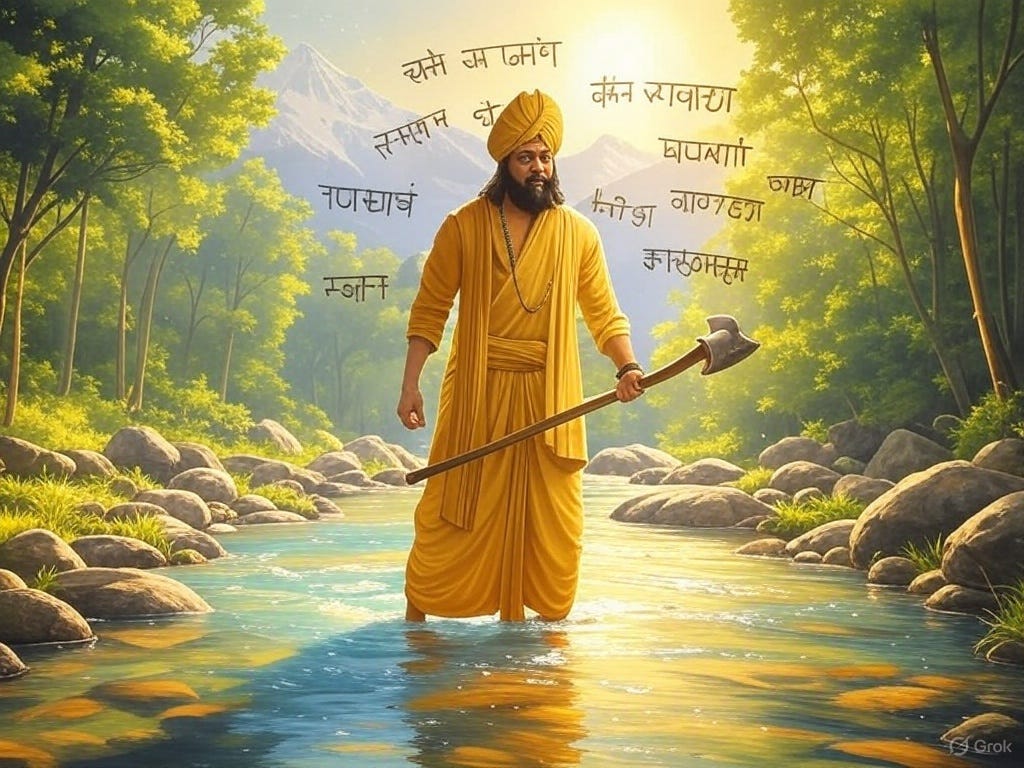Bhagwan Parshuram Jayanti 2025: The Divine Warrior-Sage
He stands as a fascinating figure in Hindu theology—a Brahmin who wielded a warrior’s weapon, an avatar who never returned to his divine form, and a teacher whose legacy spans multiple ages.
Bhagwan Parashurama Jayanti 2025
Today, April 29, 2025, marks the auspicious occasion of Lord Parashurama Jayanti, celebrating the birth of Bhagwan Parashurama, the axe-wielding warrior-sage and sixth incarnation of Lord Vishnu. Lord Parashurama stands unique among Hindu deities as he embodies both Brahminical wisdom and Kshatriya valor, representing the perfect balance of knowledge and strength. His extraordinary life story spans multiple Yugas and teaches us about righteousness, justice, and the restoration of cosmic balance.
The Divine Origin and Position in Dashavatara
Bhagwan Parashurama (Sanskrit: परशुराम), meaning “Rama with an axe,” is the sixth avatar in the Dashavatara sequence of Lord Vishnu’s incarnations. He was preceded by Vamana (the dwarf incarnation) and followed by Lord Rama. Known also as Rama Jamadagnya and Rama Bhargava, Lord Parashurama holds a unique position among Vishnu’s avatars as he is considered one of the Chiranjeevis (immortals) who will appear at the end of Kali Yuga to guide Kalki, the tenth and final avatar of Vishnu.
Born to the Brahmin sage Jamadagni and his wife Renuka, Bhagwan Parashurama appeared when the world was overwhelmed by evil. Unlike other avatars who returned to their divine form after fulfilling their mission, Lord Parashurama is believed still to exist in our world, meditating in the Mahendra Mountains. His story appears prominently in the Mahabharata and various Puranas, including the Brahmanda Purana, which details his penance and acquisition of divine weapons.
The Divine Axe: A Gift from Lord Shiva
What sets Bhagwan Parashurama apart is his primary weapon—the divine axe (Parashu) gifted to him by Lord Shiva. According to legend, Lord Parashurama undertook severe penance to please Shiva, who was impressed by his devotion. Lord Shiva not only bestowed upon him the mighty axe but also taught him Kalaripayattu, considered the mother of all martial arts.
One version of the story relates that after the Daksha Yaga incident, when Sati immolated herself, Shiva unleashed his trident in anger. Nara Narayana, an incarnation of Vishnu, intervened and redirected the weapon. When Shiva approached Nara with the trident, Nara shot an arrow that transformed into an axe, which Shiva accepted and later gifted to Bhagwan Parashurama.
The Test of Obedience: Beheading His Mother
One of the most profound stories about Lord Parashurama concerns his unwavering obedience to his father. Renuka, his mother, possessed the special ability to carry water in unbaked clay pots. One day, while fetching water, she became momentarily distracted by celestial beings playing in the river, and an impure thought crossed her mind. This brief lapse caused her unbaked pot to break.
Sage Jamadagni, through his divine insight, perceived this momentary impurity and ordered his sons to behead Renuka as punishment. While his other sons refused, Bhagwan Parashurama, steadfast in his commitment to dharma, obeyed his father’s command and beheaded his mother. Moved by his son’s extraordinary devotion, Jamadagni granted Lord Parashurama a boon, which he used to resurrect his mother. This incident established Bhagwan Parashurama’s reputation as a warrior committed to righteousness above all else.
The 21 Purges: Elimination of Kshatriyas
Perhaps the most legendary aspect of Lord Parashurama’s story is his vow to rid the earth of corrupt Kshatriyas. The event that triggered this campaign was deeply personal. King Kartavirya Arjuna, a powerful ruler with a thousand arms, once visited Jamadagni’s hermitage when the sage was absent. Despite being hospitably received, the King stole Kamadhenu, the divine wish-fulfilling cow that provided abundantly for the sage’s family.
When Jamadagni confronted him, the King (or, in some versions, his sons) killed the sage. Upon returning to the hermitage, Bhagwan Parashurama found his mother grieving, pounding her chest twenty-one times in anguish. Witnessing this heartbreaking scene, Lord Parashurama vowed to eliminate all Kshatriyas from the earth twenty-one times—once for each time his mother had struck her chest in grief.
Wielding his divine axe, Bhagwan Parashurama embarked on his mission, traveling across the land to hunt down and eliminate corrupt Kshatriya rulers. According to the Puranas, he fulfilled his vow by “destroying these Kshatriyas twenty-one times (leaving some lineages).” After completing his campaign, Lord Parashurama conducted the Ashvamedha sacrifice and distributed all his conquered possessions to Brahmin priests.
Reemergence of the Kshatriya Clan: The Practice of Niyoga
How did the Kshatriya lineage continue despite Bhagwan Parashurama’s purges? Two primary mechanisms allowed for this continuation: Lord Parashurama sparing some lineages and the practice of Niyoga.
Niyoga was an ancient Hindu practice permitting widows or wives without children to conceive with another man to ensure the continuation of the family line. This practice was especially important for preserving royal dynasties and mitigating the financial and social precariousness that childless widows faced.
The Mahabharata provides a notable example: Queen Satyavati asked her eldest son, sage Vyasa, to perform Niyoga with both widows of her younger son Vichitravirya—Ambika and Ambalika. This union resulted in the birth of Dhritarashtra, Pandu, and Vidura (the latter born from a maid named Parishrami). These children, though biologically fathered by Vyasa (a Brahmin sage), were considered Kshatriyas and legitimate heirs to the throne.
The Manusmṛti describes a child born through Niyoga as a “kshetraja” child of the husband and wife. Important rules governed this practice:
It was permitted only for procreation, not pleasure.
The appointed man had no rights to the child.
The child belonged to the woman and her (deceased) husband.
A man could be appointed for Niyoga a maximum of three times.
The act was seen as a duty of dharma.
Through this practice, Brahmin men fathered children with Kshatriya widows, but the children were raised in Kshatriya traditions and considered part of the Kshatriya lineage, ensuring its continuation despite Bhagwan Parashurama’s purges.
Bhumihar Brahmins, Swami Sahajanand Saraswati, and Bhagwan Parashurama
Kailash Jha, who retired in 2012 after an illustrious career in the political section of the U.S. Embassy in India, shares an important sociopolitical dimension of Bhagwan Parashurama's legacy. According to him, in Bihar and Eastern Uttar Pradesh, there is a caste known as the Bhumihar Brahmins who trace their lineage to Bhagwan Parashurama and consider him as their revered deity. In Western Uttar Pradesh, the Tyagi community holds an equivalent social position to the Bhumihars. Jha, who is a trustee of the Shri Sitaram Ashram associated with Swami Sahajanand Saraswati, notes that the Ashram is "a symbol of the Bhumihar community" where "Parashurama Jayanti is celebrated prominently." He further highlights that Swami Sahajanand Saraswati’s multifaceted life encompassed the roles of a sanyasi, a freedom fighter, and most importantly, a peasant leader.
Lord Parashurama in the Great Epics
Lord Parashurama makes significant appearances in both the Ramayana and Mahabharata, interacting with other avatars and key characters in Hindu mythology.
Interaction with Lord Rama
In the Ramayana, Bhagwan Parashurama appears after Rama breaks the divine bow Pinaka at Sita’s swayamvara. Hearing the loud noise, he arrives in anger and challenges Rama to string his own bow, Sharanga. When Rama not only strings the bow but also prepares to discharge it, Lord Parashurama realizes that Rama is another incarnation of Vishnu. Humbled, he acknowledges Lord Rama’s divinity and returns to his hermitage.
Teacher of Great Warriors
In the Mahabharata, Bhagwan Parashurama served as guru to several legendary warriors, including Bhishma, Drona, Karna, and Rukmi. His most famous confrontation in this epic was with his own disciple, Bhishma.
When Princess Amba sought Lord Parashurama’s help to compel Bhishma to marry her, Bhagwan Parashurama commanded his student to do so. When Bhishma refused, citing his vow of celibacy, a tremendous battle ensued between teacher and student that lasted twenty-three days without resolution. Finally, at the behest of divine sages, Lord Parashurama ended the conflict, declaring it a draw.
Bhagwan Parashurama Kshetra: The Land Created by His Axe
One of the most enduring legends associated with Lord Parashurama concerns the creation of the western coastal regions of India, particularly Kerala. According to tradition, Bhagwan Parashurama threw his axe from the mountain into the sea, causing the waters to recede and new land to emerge. This reclaimed land, stretching from Gokarna to Kanyakumari, was initially filled with salt and unsuitable for habitation.
Lord Parashurama then invoked the snake King Vasuki, who purified the soil with his holy poison, transforming it into fertile land. Out of gratitude, Vasuki and all snakes were appointed protectors of this new territory. This land became known as “Bhagwan Parashurama Kshetra” (“The Land of Bhagwan Parashurama”), and Kerala is still referred to by this name.
Celebrating Lord Parashurama Jayanti
Lord Parashurama Jayanti coincides with Akshaya Tritiya, falling on the Tritiya tithi (third day) of the Shukla Paksha (bright fortnight) in the month of Vaishakh. In 2025, this auspicious day falls on Tuesday, April 29, with the Tritiya tithi beginning at 5:31 PM on April 29 and ending at 2:12 PM on April 30.
Devotees observe various rituals and traditions on this day:
Ritual Bath – Many begin the day with a ceremonial bath before sunrise, symbolizing purification of body and soul.
Fasting – Devotees observe a fast as a spiritual practice, denoting discipline and sacrifice.
Temple Worship – Special prayers, bhajans, kirtans, and havans are performed in temples dedicated to Bhagwan Parashurama.
Processions – Many regions organize grand Shobha Yatras and Kalash Yatras, where devotees participate in colorful processions.
Charitable Acts – Following Lord Parashurama’s example of generosity, many devotees make donations and organize free medical camps or educational seminars.
Notable temples dedicated to Bhagwan Parashurama exist throughout India, with the Parshuram Mandir in Mokama, Bihar, being particularly famous. The annual celebrations at this temple have gained such popularity that the Bihar government has officially recognized it as a state festival.
The Cosmic Balance: Divine Justice
Lord Parashurama’s legend teaches us about the delicate balance of human civilization. As the only Brahmin avatar of Vishnu who took up arms, he embodies the principle that sometimes strong measures are necessary to preserve dharma (righteousness). His story reminds us that when power is misused, cosmic justice will eventually restore balance.
Though traditionally Brahmins were associated with knowledge and spiritual practices rather than warfare, Bhagwan Parashurama’s unique position demonstrates that wisdom and strength are not mutually exclusive. His character blends courage, aggression, and warfare with serenity, patience, and prudence. He represents the idea that knowledge without the will to protect it becomes meaningless, and power without wisdom leads to corruption.
As we celebrate Lord Parashurama Jayanti today, we honor not just a deity but a principle—that preservation sometimes requires transformation, and that divine justice works in mysterious ways to maintain cosmic equilibrium. Lord Vishnu, the preserver, sometimes manifests as the destroyer of evil to ensure the continuation of good.
In Summary
Bhagwan Parashurama stands as one of the most fascinating figures in Hindu mythology, rather theology—a Brahmin who wielded a warrior’s weapon, an avatar who never returned to his divine form, and a teacher whose legacy spans multiple ages. His story reminds us that righteousness sometimes demands decisive action, that obedience to dharma may require personal sacrifice, and that divine justice eventually restores balance to creation.
On this auspicious Lord Parashurama Jayanti, as devotees across India offer prayers and participate in celebrations, we are reminded of the timeless values that his legend embodies—courage tempered with wisdom, power guided by principle, and an unwavering commitment to dharma. May his blessings bring strength, courage, and righteousness to all.
_________________________________________________________
Note: This article is based on Hindu religious texts and traditions. As with many ancient stories, variations exist across different regions and texts. Nothing here is meant to offend any religious sentiments or beliefs. If, despite best intentions, anyone finds anything offensive, I offer an unqualified apology in advance.
References
https://www.bankbazaar.com/indian-holiday/parshuram-jayanti.html
https://theharikumar.com/parashurama-srishti-tulu-nadu-kerala/
https://www.ethnictanjorearts.com/parashurama-jayanti-celebrating/
https://www.cottage9.com/blog/bhagwan-parshuram-jayanti-significance-celebrations/
https://www.wisdomlib.org/hinduism/book/the-padma-purana/d/doc365825.html
https://study.com/academy/lesson/parashurama-overview-mythology-facts.html
https://www.newindianexpress.com/magazine/voices/2025/Jan/18/who-did-parashuram-actually-kill
https://www.exoticindiaart.com/book/details/parshuram-puran-mzc555/
https://www.wisdomlib.org/hinduism/compilation/puranic-encyclopaedia/d/doc241820.html
https://www.apnisanskriti.com/story/the-story-of-parshuram-814
https://upload.wikimedia.org/wikipedia/commons/f/fc/Parashurama.jpg
https://www.swaminarayan.info/library/festivals/parshuram-jayanti





